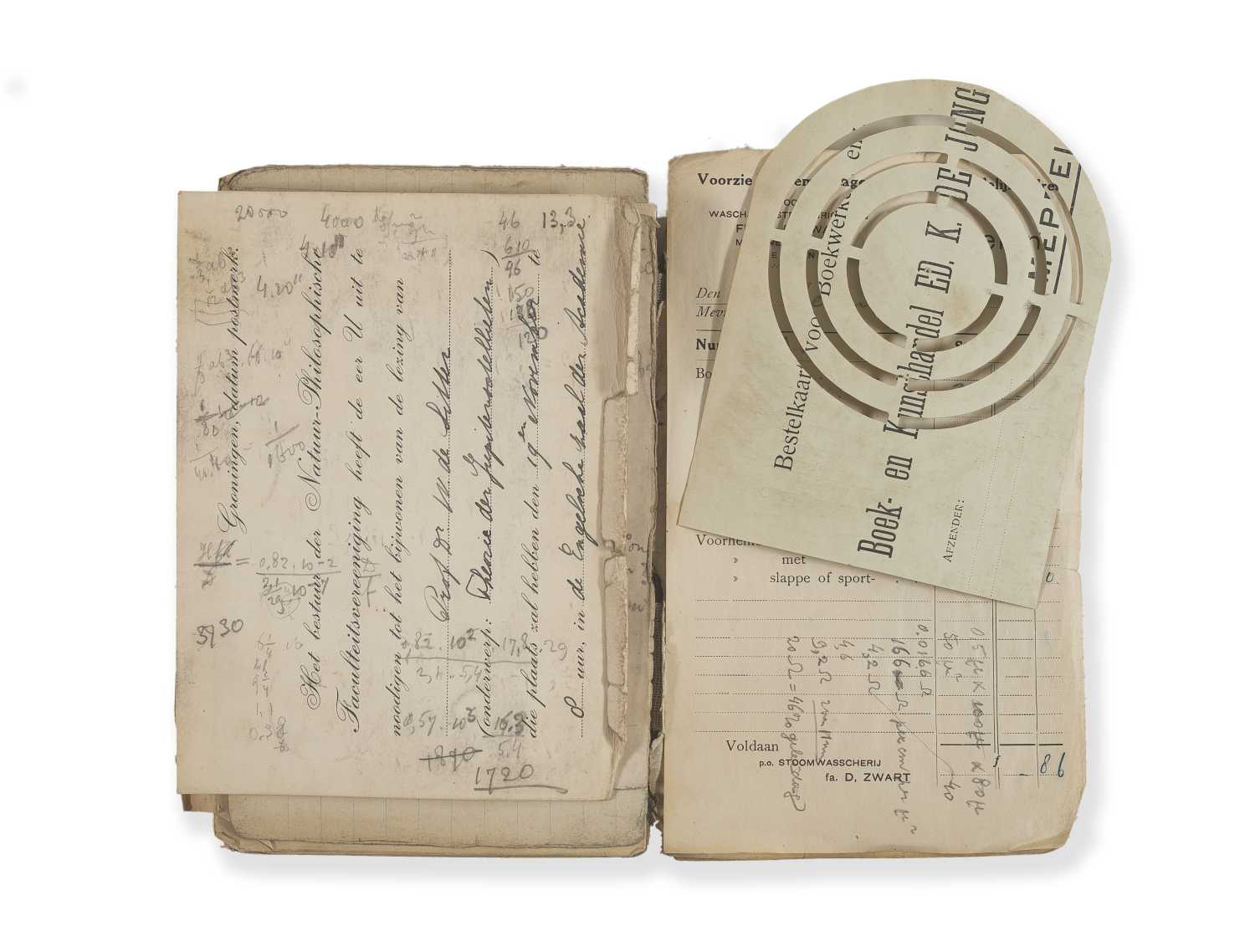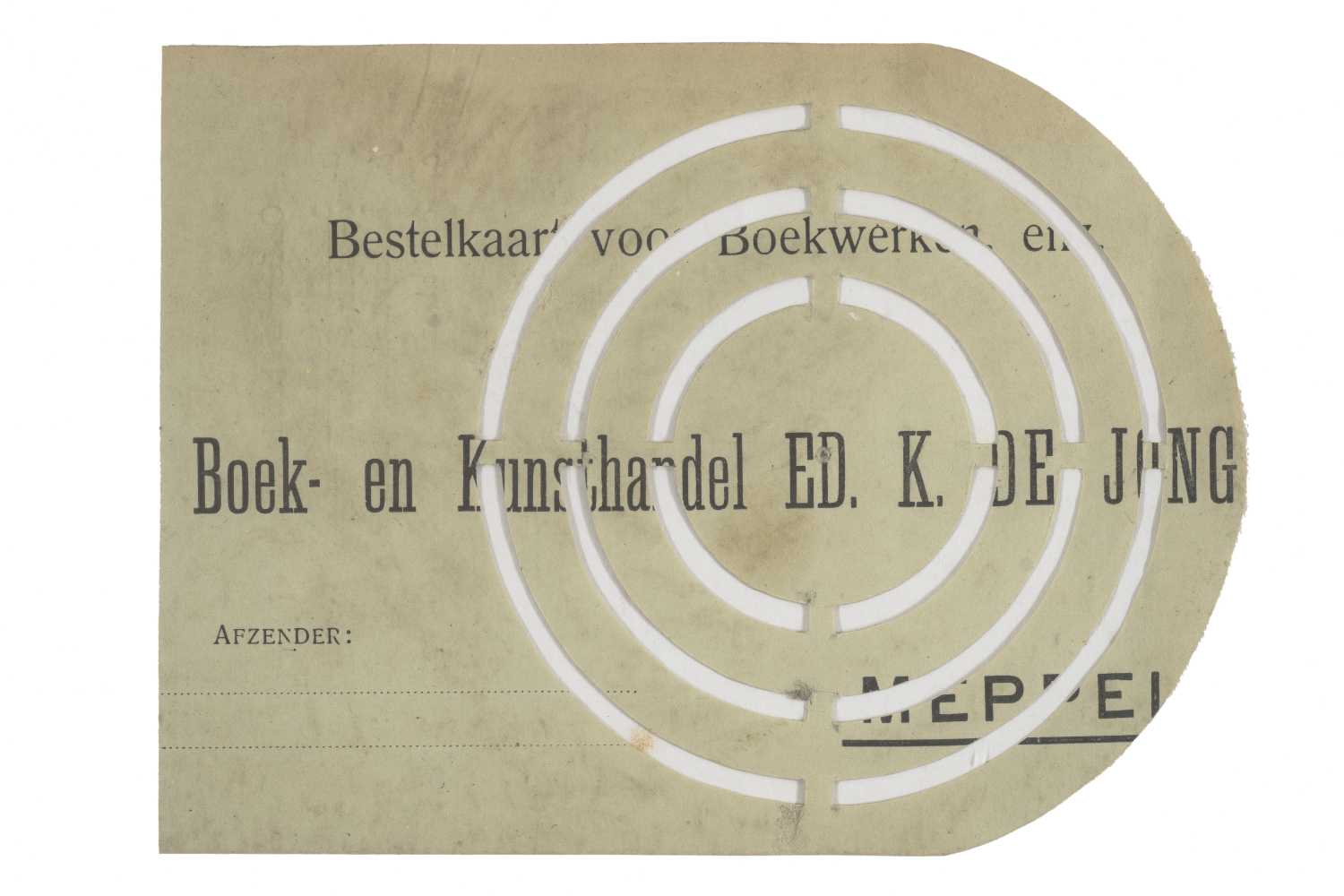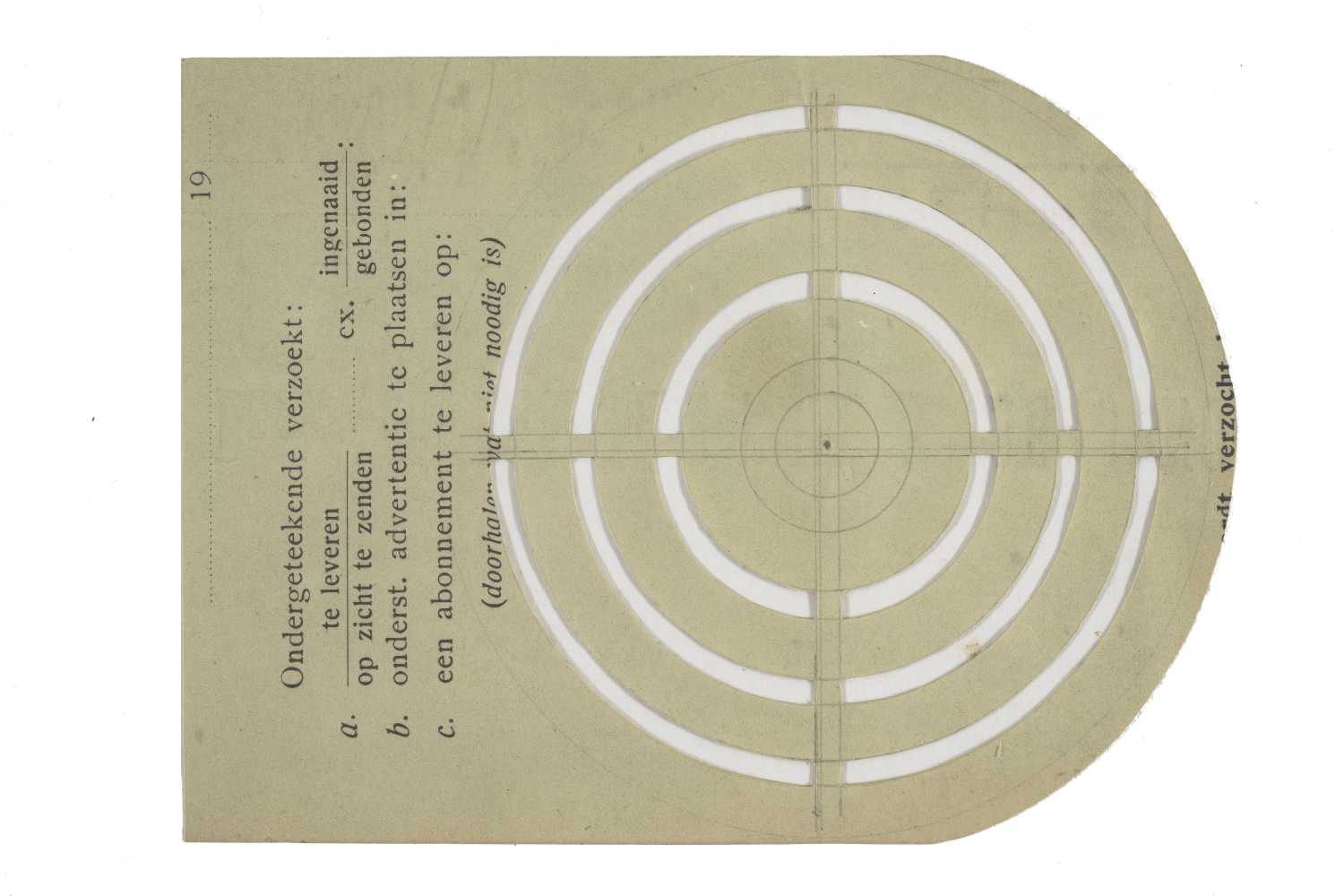New Light on Zernike?
That morning, several weeks ago, I had gone to the University Library’s Special Collections department with the intention of looking at the first volumes of the Universiteitskrant (in September, the Universiteitskrant will be celebrating its 50th birthday, which is definitely an event worthy of publication). But the day didn’t turn out quite as I had expected. In passing, I decided to ask about the Zernike archive. For the new permanent exhibition at the University Museum, I had recently been looking into Nobel Prize winner and Professor of Mathematical Physics Frits Zernike (1888-1966), one of the University of Groningen’s icons. In the literature, I discovered a note referencing the Zernike archive, which was supposed to be part of the University Library, but that I was unable to locate in the catalogue.
A mere five minutes after inquiring about the archive, a description of the Zernike archive was delivered to my work station. Fast forward a little and I found myself standing next to staff member Evert Jan Reker, staring with some degree of wonder at the row of archive boxes in the vault. That morning and the following days, I did not go near the Universiteitskrant’s volumes. Instead, I threw myself into discovering the contents of all sixteen boxes and became more excited with each and every box that I went through. Whether this archive will truly shine another light on Zernike re-mains to be seen, but at least it contains enough material to get a head start on a biography of Zernike.
The archive was actually created in much the same way. In the 1970s and ‘80s, Hendrik Brinkman (1909-1994), who worked as professor of experimental physics since 1950 and was the founder of the KVI-Center for Advanced Radiation Technology in Groningen, and his assistant O.S. Kramer, began collecting a plethora of documents, objects and audio-visual material of and about Zernike. Brinkman wanted to secure Zernike’s scientific legacy and had the intention of writing a biography about Zernike. ‘His work on physics is easily accessible through his publications’, Brinkman wrote to C.E. Bleeker in 1977. Bleeker was director of the Bleeker firm at the time, and often cooperated closely with Zernike. ‘But trying to get an idea of his person, how he was and interacted with others, is much harder’. [1] Brinkman later expanded on his plans: he wanted to publish a historical description of the practice of physics in Groningen between 1900-1950, in which he aimed to pub-lish a biography about the life and work of Zernike and Brinkman’s predecessor, Dirk Coster. [2]
Brinkman and Kramer were extremely thorough. The duo approached a number of organizations and individuals with requests for information about or items belonging to Zernike, but also about his family, including father, mother, wives, daughter, son, sisters, brother and other family mem-bers. The result is an extensive and varied archive. First and foremost, the archive contains pieces by Zernike himself. His Higher Civic School diploma, his university degrees, but also countless note-books containing notes and drawings from his time as a student, as a lecturer and as a professor, his lectures, reports of meetings, the documents relating to his nomination and awarding of the Nobel Prize in 1953, various other distinctions and, of course, correspondence to and from Zernike.
These include a letter of congratulations from Dutch physicist and Nobel Prize winner H.A. Lorentz from 1915, in which he wishes Zernike the best of luck on the completion of his dissertation and his graduation. Lorentz thanks Zernike for the copy of his dissertation and explains that, although he has not yet read it in full, he found it to be very important:
I have not yet had the time to read the entire document, but I am impressed with not only your discourse but I also have a very vivid impression of the great care that you have put in-to your work and the acuity and clarity with which you are able to discuss complex theoreti-cal issues. Your research is undoubtedly an important contribution to the body of knowledge about the group of phenomena to which you have dedicated your research. It is my sincere hope that you will continue to be as happy in your future scientific career. [3]
This note that Lorentz sent to Zernike was not included in the two volumes of the The Scientific Correspondence of H.A. Lorentz. However, a letter was included in part II, from Lorentz to Paul Eh-renfest (dated 30 April 1915), in which Lorentz writes: ‘[…] I was much aggrieved to read the news of Zernike’s appointment. What a shame that people in Groningen have categorically refused to listen to us [...]’. [4] Is the aforementioned cause to believe that Lorentz may not have been happy about Zernike’s appointment in Groningen? And who exactly had been recommended for the professorship in mathematical physics and theoretical mechanics by those in Leiden? [5]
Secondly, the archive also contains transcripts of the conversations Brinkman had with Zernike’s family members. Brinkman has extensively conversed and corresponded with three of Zernike’s sisters, with his daughter, his son and his cousin; the theoretical physicist Nico van der Kampen. Brinkman has also spoken to colleagues, PhD students and various manufacturers that Zernike of-ten worked with, including A. Brice, C.P. Saylor and the previously mentioned manufacturer C.E. Bleeker. Those who had been living and working abroad were ‘interviewed’ remotely by Brinkman, meaning that he asked them to tape their answers to his questions or write them down and send everything by post. This correspondence and the transcripts of the taped conversations enrich our knowledge of Zernike and provide a colourful impression of his family life and his relationships with colleagues and PhD students. [6] The correspondence, the items and interview documents submitted, have been alphabetically ordered: from C.E. Bleeker to C. Zwikker; a total of 41 folders. Other names include M. Bottema, C.J. Bouwkamp, J.G. van Cittert-Eymers, D. Coster, J.C. Kapteyn [7], R. de Laer Kronig, W.J.H. Moll, J.H. Oosterwijk (Zernike’s devoted instrument-maker), O.J. Poppema and G.W. Rathenau, among other prominent scientists.
Finally, the archive contains information about the Zernike chair established in 1979, an overview of the streets and schools named after Zernike, busts and portraits of Zernike in Groningen, but also a bibliography of Zernike, a list of his students and PhD students and their theses and dissertations.
In the short time that I have spent investigating Zernike, I have already found various great works. For example, what do you think of this letter to Brinkman, written by Zernike’s former colleague, mathematician Bartel van der Waerden:
‘Dear colleague,
It is with deep regret that I have to inform you that I have not a single letter from Zernike in my archive of letters. As you say: Zernike wrote very few letters. My father, Dr Theo van der Waerden, who taught Mathematics and Mechanics at the second five-year Higher Civic School in Amsterdam, remembers having Zernike in his classes. He immediately knew that Zernike was extraordinarily gifted and he would allow Zernike to doze off during classes that he found boring. When the teacher would move on to the next topic, he would yell: “Zernike, wake up!” and then Zernike would listen until he understood the subject matter. My father told me all of this himself. My father was also able to tell me that, as a student, Zernike had developed a probability theory of the Bell and Hammer game. But I have never seen this theory with my own eyes. Zernike would often say astute or hilarious things. He once looked in my book entitled Science Awakening and spotted an image of Plato. He said “Oh yes, that’s very useful! Now if you run into that fellow, you’ll recognize him immediate-ly.”’ [8]
‘I also discovered that Zernike loved to go to dance class when he was young [9] and that according to M. Bottema, Zernike’s PhD student, Zernike’s most striking characteristic was ‘his economic way of thinking and acting’. No small-talk to begin a conversation and he even refrained from exchanging the usual pleasantries. When Zernike returned from America and I ran into him by accident in a dark room at the lab, his first question was: “Where is the developer?”’. [10]
In 1988, on the occasion of the commemoration of Zernike’s 100th birthday, Brinkman and Kramer held a conference at the Academy Building. Simultaneously, an exhibit was devoted to the life and work of Zernike at the University Museum. Brinkman wrote a short biography of Zernike and the associated catalogue and donated his archive to the University Museum that same year. [11] It is likely that all the pieces collected by him and Kramer were initially kept in a desk or a cabinet, because the description includes references to drawers.
Although the former curator of the University Museum acknowledged the value of the sizeable archive, it appears to have fallen into obscurity. [12] Finally, part of the archive ended up at the University Library. No inventory was created; however, a limited description has by now been add-ed to the catalogue. Although Brinkman wrote a brief biography of Zernike, the scope and versatili-ty of the archive once again requires a thorough and careful review. Perhaps this could be useful to write a more sizeable biography of Zernike or to serve as additional material for the history of the practice of physics in the Netherlands in the twentieth century. I myself will not be taking on the task, as the volumes of the Universiteitskrant are still sitting on that trolley waiting for me, but this is my way of bringing this archive to the attention of fellow historians.

Finally, I also found something that is a bit of a mystery to me. I found it in the back of one of Zer-nike’s many notebooks. The notebook dates back to around 1920. On an order form, as far as I can tell, Zernike drew a shape in pencil and then cut out parts of it. [13]
What could this be? If you have any suggestions, please do not hesitate to respond via email or Twitter @BijzCollecties.
Notes
- Brinkman in a letter to C.E. Bleeker. Dated 1 December 1976. University Library, Special Collections, Zernike archive, Drawer 3, box 1, folder Bleeker, Bok and Bottema.
- Brinkman in a letter to F. Brons. Dated 1 February 1980. University Library, Special Collections, Zernike ar-chive, Drawer 3, box 1, folder C.J. Bouwkamp, A. Brice, F. and H.H. Brons, J.G. van Cittert-Eymers.
- H.A. Lorentz in a letter to Frits Zernike. Dated 21 February 1915. University Library, Special Collections, Zer-nike archive, Drawer 2, box 1, folder University of Groningen fellowship 1913-1915.
- A.J. Kox ed., The Scientific Correspondence of H.A. Lorentz.Volume 2, the Dutch Correspondents, no. 170.
- More on this will undoubtedly be available at the archive of Curators in the Groningen Archives, which are currently sadly closed due to the pandemic.
- The cassette tapes are located at the University Museum.
- The folder about the astronomer Kapteyn contains six letters from Kapteyn to Zernike from the period 1912-1914, that Brinkman received from Kapteyn’s son in law. These letters have been described previously. See: Petra van der Heijden, ‘The “Lost Letters” of J.C. Kapteyn’, in: P.C. van der Kruit, K. van Berkel eds., The legacy of J.C. Studies on Kapteyn and the Development of Modern Astronomy (Dordrecht, Boston, London 2000) 31-52, therein 48-49.
- Letter of Bartel van der Waerden to Hendrik Brinkman. Dated 19 February 1977. University Library, Special Collections, Zernike archive, Drawer 2, box 1, folder primary school/Higher Civic School 1894-1905. Van der Waerden published Science Awakening in 1950.
- Nico van Kampen in a letter to Brinkman. Dated 25 March 1977. University Library, Special Collections, Zer-nike archive, Drawer 3, box 1, folder C.J. Bouwkamp, A. Brice, F. and H.H. Brons, J.G. van Cittert-Eymers. Van Kampen was Professor of Theoretical Nuclear Physics at Utrecht University and one of Zernike’s cousins.
- Bottema in personal notes about Zernike to Brinkman. University Library, Special Collections, Zernike ar-chive, Drawer 3, box 1, folder Bleeker, Bok and Bottema.
- H. Brinkman red., Frits Zernike. Nobel Prize laureate, 1888-1966 (Groningen 1988), 1.
- Idem, 2.
- University Library, Special Collections, Zernike archive, Drawer 2, box 1, folder professorship 1920-1937.


![The letter of H.A. Lorentz to Frits Zernike. [Dated 21 February 1915]](/library/_shared/images/BC/archief-zernike-03.jpg)
![The letter of H.A. Lorentz to Frits Zernike. [Dated 21 February 1915]](/library/_shared/images/BC/archief-zernike-04.jpg)
![Letter from Bartel van der Waerden to Hendrik Brinkman. [Dated 19 February 1977]](/library/_shared/images/BC/archief-zernike-05.jpg)
![Letter from Bartel van der Waerden to Hendrik Brinkman. [Dated 19 February 1977]](/library/_shared/images/BC/archief-zernike-06.jpg)

